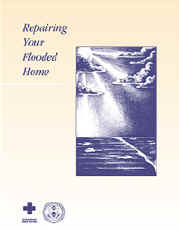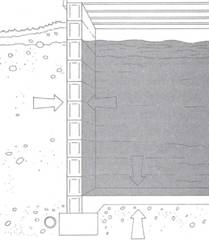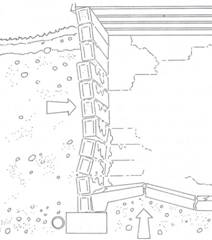After A Flood
Help
If you’ve been flooded, your home and its contents may look beyond hope, but many of your belongings can be restored. If you do things right, your flooded home can be cleaned up, dried out, rebuilt, and reoccupied sooner than you think.
 | You should get a copy of Repairing Your Flooded Home (ARC4477), published jointly by the American Red Cross and the Federal Emergency Management Agency. You can download it by clicking here. You can also find it on the Red Cross website and at the South Holland Public Library. |
Professional help. Many people can do a lot of the clean up and repairs discussed in this guide. But if you have technical questions or do not feel comfortable doing something, get professional help. If there is a federal disaster declaration, a telephone “hotline” will often be publicized to provide information about public, private, and voluntary agency programs to help you recover.
Take Care of Yourself First
You and your family have been through a disaster. Your life has been disrupted and you must allow time for things to return to normal. You should recognize that the flood can take its toll on you as well as your property. You need to look after yourself and your family while you focus on cleanup and recovery.
Important Health Notes:
- Wash your hands thoroughly. This is especially important before eating, cooking, or smoking.
- Confirm that the water is clean and safe. Don’t drink it or wash dishes until you’re sure.
- Disinfect dishes and all items that floodwaters touched.
- Watch out for fatigue. When your body is tired, you are more prone to accidents, back strain, and depression.
- Report health hazards. Call the Village if there are rats, animal carcasses, dangerous chemicals, or other hazards on your property.
Play it safe. The dangers are not over when the water goes down. Your home’s foundation may have been weakened, the electrical system may have shorted out, and floodwaters may have left behind things that could make you sick. When in doubt, throw it out. Don’t risk injury or infection.
Watch for signs of stress. Your hidden enemy is stress. Watch for signs of trouble like short tempers, getting upset over little things, having difficulty sleeping, bad dreams, aches, pains, stomach problems, apathy, and depression. These are ways your body tells you that times are difficult. Reactions to stress are common and usually temporary. If you cannot shake feelings of despair or other telltale signs of stress, get professional help.
Care for your children. Watch your children closely. You can expect to see them display fear or symptoms of stress. Be understanding. Remember, they are going through a rough time too.
Check your House Outside
Each year about 150 people die because of floods. Many of those fatalities are due to electrocution or other accidents that occur after the floodwaters have gone down. Your first job is to make sure everything is safe.
Follow these steps:
Check with your insurance agent to see if some of your cleanup and repair work is covered. If so, you may want to hire professional help for the rest of these steps.
Walk around the outside of your house. Remove tree limbs or other trash that may have landed on or floated into the house. Check for loose power lines and gas leaks.
Gas: You can detect leaking gas by the putrid, rotten egg smell of chemicals that have been added to it to make a leak noticeable. If you think there’s a gas leak, see Gas Leaks for more guidance.
Avoid electricity. Stay away from power lines and electrical wires. The number two flood killer after drowning is electrocution. Electrical current can travel through water. Report downed power lines to Commonwealth Edison at 1-800-334-7661 (1-800-Edison-1). Call 911 if people are in danger.
Check the foundation for cracks or other damage. Examine porch roofs and overhangs to be sure they still have all their supports. Look for gaps between the steps and the house. If you see damage, have the Planning and Development Department check the house before you go in.
Turn off the electricity at your house, even if the power company has turned it off (they may turn it back on when you’re not ready). If you have to go through water to get to your fuse box or breaker box, if the boxes are wet, or if you’re not comfortable with electrical matters, call an electrician. Otherwise, you can follow the instructions to Turn Off the Electricity.
Turn off the gas. See the instructions to Turn Off the Gas.
Check your House Inside
Go inside carefully. It may be easier to enter your house through a window if the door won’t open easily. Look carefully at the ceiling before you go in to be sure it is not ready to fall. Do not smoke or use candles, gas lanterns, or other open flames until the house has been well ventilated. There may be explosive gas.
Rescue the most valuable items. Find and protect the “irreplaceables,” like money, jewelry, insurance papers, photographs, and family heirlooms. Wash the mud off before they have a chance to dry. Put them in a safe place like the upper story (if it’s dry), a plastic bag, or take them to a friend’s home. Wash the mud off photographs and papers and put them in a freezer for clean up later when you have the time to do a careful job.
Keep the damage from getting worse. Open the windows and doors (if weather permits) to reduce the moisture and get rid of any gas. Cover holes in the roof, walls, or windows with boards, tarps, or plastic sheeting to keep out the wind and rain.
Check for broken or leaking water pipes. If you find any, turn off the water supply by turning off the valve at your water meter. If sewer and water lines are damaged, don’t use toilets or sinks. If the water pipes are not leaking, you can use your tap water for hosing things down and cleaning. But do not drink or cook with tap water until the Village declares it safe.
Draining a Basement
Water in the saturated ground puts tremendous hydrostatic pressure on your basement walls and floors. The water inside your flooded basement is counteracting this pressure. If you don’t follow the instructions in the box for emptying the basement gradually, your walls and floor will lose the support they need to counteract the pressure from the water outside. The weight of the saturated earth could then cause the walls to crack and collapse, buckling the floors and seriously damaging your home.
 Water pressure increases with depth. Walls are built to handle 1 – 2 feet of water pressure. Water in a basement equalizes the tremendous pressure of the water in the ground. |  If the basement is pumped dry while there is still water in the ground, the water pressure can break the walls and/or the floor. |
To drain a basement safely, follow these steps:
- Make sure the electricity is off.
- If there is no floodwater on top of the ground, start pumping the water out of the basement.
- Pump the water level down two to three feet. Mark the level and wait overnight.
- Check the water level the next day. If the water went back up, it’s still too early to try to drain the basement.
- Wait overnight. Then pump the water down two to three feet again. Check the level the next day.
- When the water stops going back up, pump down another two to three feet and wait overnight. Repeat steps 4 through 6 until all water is pumped out of the basement.
Cleanup
Get rid of the mud and silt. Most of the health hazards brought by a flood are in the mud and silt that is left after the water drains away. It is therefore very important to clean it out as soon as possible. This is a lot easier if you do it before the mud dries out.
Follow these steps:
- First, shovel out the mud.
- Next, make sure the electricity is turned off. Remove all light bulbs from sockets that have been flooded. Throw away flooded wall switches and outlets. They should be replaced later with new ones.
- Hose the house down, inside and out. If you have an attachment that sprays soap, wash and then rinse the walls and floors. Hose the furniture, too, and other major items that got muddy.
- Double check that the electricity is off, then thoroughly hose out the electrical outlets, switch boxes, and light sockets that you opened up.
- Don’t let the water sit on the floor too long. Mop it up right away, especially if your floor is particle board or another wood product that tends to fall apart when wet.
- Remove all wet drywall and insulation. Even if it looks dry, in contains pollutants that you don’t want in your house.
Clean everything that got wet. Flood waters have picked up sewage and chemicals from roads, farms, factories, and storage buildings. Spoiled food and flooded cosmetics and medicines are health hazards. When in doubt, throw them out.
For more information: Get a copy of Repairing Your Flooded Home. See the Help section.

